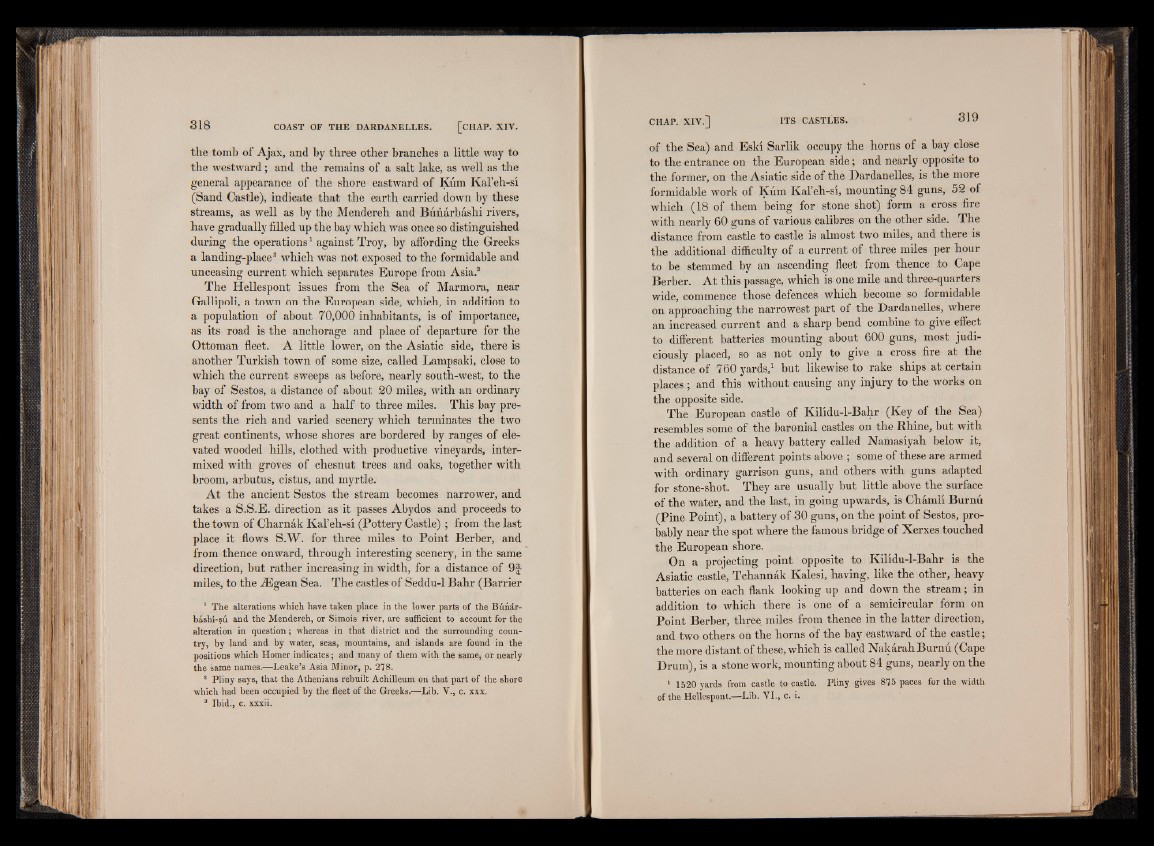
the tomb of Ajax, and by three other branches a little way to
the westward; and the remains of a salt lake, as well as the
general appearance of the shore eastward of Kum Kal’eh-si
(Sand Castle), indicate that the earth carried down by these
streams, as well as by the Mendereh and Bunarbashi rivers,
have gradually tilled up the bay which was once so distinguished
during the operations1 against Troy, by affording the Greeks
a landing-place2 which was not exposed to the formidable and
unceasing current which separates Europe from Asia.3
The Hellespont issues from the Sea of Marmora, near
Gallipoli, a town on the European side, which, in addition to
a population of about 70,000 inhabitants, is of importance,
as its road is the anchorage and place of departure for the
Ottoman fleet. A little lower, on the Asiatic side, there is
another Turkish town of some size, called Lampsaki, close to
which the current sweeps as before, nearly south-west, to the
bay of Sestos, a distance of about 20 miles, with an ordinary
width of from two and a half to three miles. This bay presents
the rich and varied scenery which terminates the two
great continents, whose shores are bordered by ranges of elevated
wooded hills, clothed with productive vineyards, intermixed
with groves of chesnut trees and oaks, together with
broom, arbutus, cistus, and myrtle.
At the ancient Sestos the stream becomes narrower, and
takes a S.S.E. direction as it passes Abydos and proceeds to
the town of Charnak Kal’eh-si (Pottery Castle) ; from the last
place it flows S.W. for three miles to Point Berber, and
from thence onward, through interesting scenery, in the same
direction, but rather increasing in width, for a distance of 9 f
miles, to the TEgean Sea. The castles of Seddu-1 Bahr (Barrier
1 The alterations which have taken place in the lower parts of the Bundr-
bashi-su and the Mendereh, or Simois river, are sufficient to account for the
alteration in question; whereas in that district and the surrounding country,
by land and by water, seas, mountains, and islands are found in the
positions which Homer indicates; and many of them with the same, or nearly
the same names.—Leake’s Asia Minor, p. 278.
2 Pliny says, that the Athenians rebuilt Achilleum on that part of the shore
which had been occupied by the fleet of the Greeks.—Lib. V., c. xxx.
3 Ibid., c. xxxii.
of the Sea) and Eski Sarlik occupy the horns of a bay close
to the entrance on the European side; and nearly opposite to
the former, on the Asiatic side of the Dardanelles, is the more
formidable work of Kum Kal’eh-si, mounting 84 guns, 52 of
which (18 of them being for stone shot) form a cross fire
with nearly 60 guns of various calibres on the other side. The
distance from castle to castle is almost two miles, and there is
the additional difficulty of a current of three miles per hour
to be stemmed by an ascending fleet from thence to Cape
Berber. At this passage, which is one mile and three-quarters
wide, commence those defences which become so formidable
on approaching the narrowest part of the Dardanelles, where
an increased current and a sharp bend combine to give effect
to different batteries mounting about 600 guns, most judiciously
placed, so as not only to give a cross fire at the
distance of 760 yards,1 but likewise to rake ships at certain
places ; and this without causing any injury to the works on
the opposite side.
The European castle of Kilidu-l-Bahr (Key of the Sea)
resembles some of the baronial castles on the Rhine, but with
the addition of a heavy battery called Namasiyah below it,
and several on different points above ; some of these are armed
with ordinary garrison guns, and others with guns adapted
for stone-shot. They are usually but little above the surface
of the water, and the last, in going upwards, is Chamli Burnu
(Pine Point), a battery of 30 guns, on the point of Sestos, probably
near the spot where the famous bridge of Xerxes touched
the European shore.
On a projecting point opposite to Kilidu-l-Bahr is the
Asiatic castle, Tchannak Kalesi, having, like the other, heavy
batteries on each flank looking up and down the stream; in
addition to which there is one of a semicircular form on
Point Berber, three miles from thence in the latter direction,
and two others on the horns of the bay eastward of the castle;
the more distant of these, which is called Nakarah Burnu (Cape
Drum), is a stone work, mounting about 84 guns, nearly on the
1 1520 yards from castle to castle. Pliny gives 875 paces for the width
of the Hellespont.—Lib. VI., c. i.